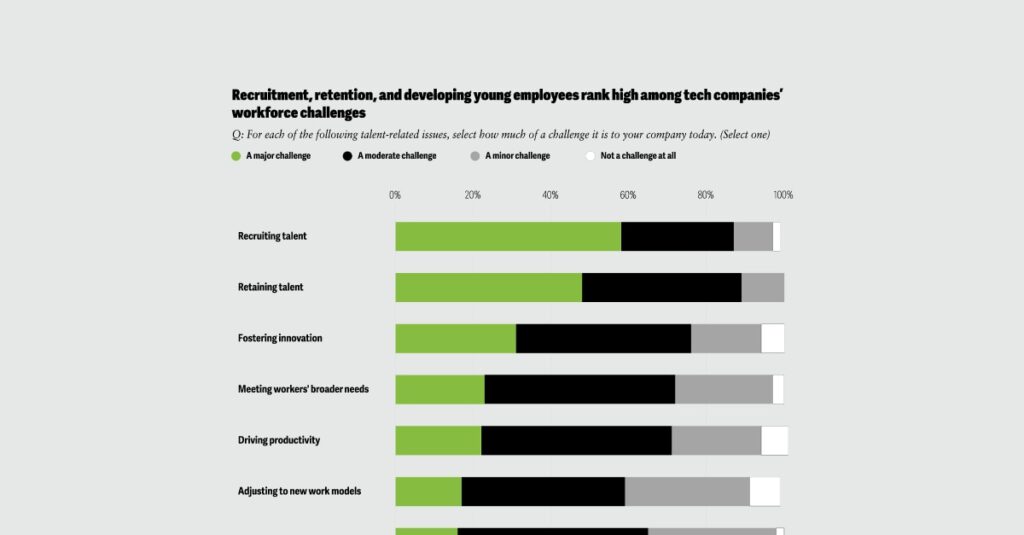In a Deloitte survey of technology industry leaders, talent issues were seen as both their biggest challenge and their biggest opportunity. Over the past six months, talent issues have remained steady as the No. 2 strategic challenge (behind competition and market disruption).3 Digging deeper, nearly 90% of leaders say that recruiting and retaining talent is a medium or high challenge. Additionally, 72% rate “meeting the broad range of employee needs” as a medium or high challenge (exhibit).
Businesses will continue to struggle to navigate returns to the office, layoffs, and changing employee preferences. Two areas leaders found particularly challenging were finding talent with highly in-demand tech skills and helping younger employees thrive in a changing workplace.
Highly skilled jobs remain in short supply
Thanks to layoffs and more cautious hiring practices, talent retention issues aren’t as bad as they once were.4 But executives still struggle to fill senior technical roles that require systems architects, cybersecurity specialists, and AI expertise.
One leader cited the roles that are hardest to fill: “On the technical side, I would say security and systems architects. People who understand how things fit together. I call them unicorns. People who can really sit and think about how software, network, hardware, cloud, data all fit together. Those people are really hard to find.”
This skills shortage appears to be hindering companies’ ability to take on new projects. “There are a lot of initiatives underway, but we don’t have the talent to kickstart them. We have the budgets, but we don’t have the talent with backgrounds in AI, ML, automation, cloud security, cloud infrastructure, etc. We really want to improve our security and take it to the next level, but we don’t have the talent,” lamented one executive.
Finding cybersecurity professionals is a perennial challenge, and current demand remains high.5 “Talent has always been a challenge for cybersecurity…the problem has only become more complicated over the past two years with the pandemic, working from home, and companies adopting new tools and technologies to secure their environments,” one leader explained.
The proliferation of new generative AI tools has led to an explosion in the number of job postings mentioning AI since the beginning of this year.6 Engineers, data scientists, and developers with AI expertise are in high demand, not just those who can build from scratch, but also those who can work with new models and tools.
The next generation of talent is struggling to connect
The second biggest workforce challenge tech leaders surveyed identified is meeting the desire of younger workers to work from home while also meeting the larger needs of their companies. Leaders said they’re struggling to find opportunities to connect and build a cohesive culture. “Gen Z loves virtual environments, but at the same time, it’s really hard to network on Zoom or Teams. I think we’re just trying to figure out how to best support that,” one leader said.
Many of these younger employees entered the workforce during the pandemic and are in the midst of a debate about which work model is best: a fully flexible environment, a structured hybrid approach (e.g., working in the office 2-3 days a week), or fully mandatory in-office. Each has its pros and cons.7
According to one leader, the key is flexibility: “I’ve seen CEOs take a hard-line stance, and it’s understandable, because I think there will be some loss of productivity and collaboration, especially when new talent is just joining the workplace. Conversely, if we don’t embrace this flexibility, we’ll lose out on our best talent. The conversation always seems to go to one extreme or the other. I happen to be somewhere in the middle. The key is to listen, adapt and adjust.”
Recommendations for technology industry leaders to consider
Competition for specialized talent and nurturing junior talent is a challenge, but there are proven tactics companies can leverage. In the short term, project-based outsourcing is an option for clearly defined projects and pilots. Focusing on skills over background can also help alleviate talent shortages. Widen the talent pool opening and look for talent from diverse backgrounds (e.g., military veterans, community college graduates). Offering new education and certification opportunities for current employees in emerging technology fields can be a cost-effective long-term solution. Consider looking for internal candidates with the right foundational skills, human competencies, and untapped potential that can be nurtured. 8 With a limited supply of technical talent, flexibility is key. 9
In today’s hybrid work environment, many companies are also experimenting with new approaches to mentorship, career guidance, and training. New hires and those just starting out in their careers are full of enthusiasm, curiosity, and ideas. Companies can harness that passion by having younger employees co-create these types of support programs or employ reverse mentoring (junior employees advising more experienced employees).10 One executive stated, “If a company has a reputation for having a really good mentoring program, that to me is a magnet for early-career employees to actually join the company.”
Tech companies need to not only attract workers with already valuable skills, but also nurture those skills. This is hard to do in an environment where younger workers don’t have many opportunities. In the rush to cut costs, tech companies may have unintentionally let go of potential tech “unicorns” and future leaders. Mentoring programs, flexible work arrangements, and clear paths for skills development can build a company’s talent pipeline and increase the loyalty of younger employees.

